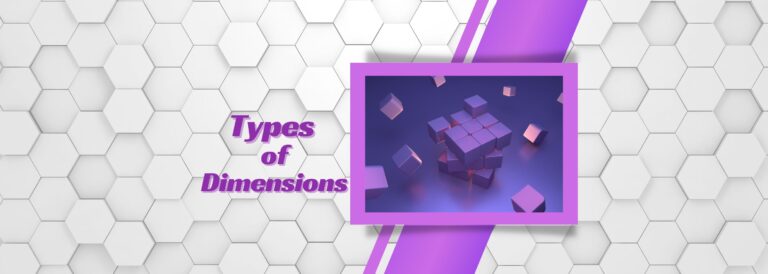Table of Contents
ToggleIntroduction
Dimensions are an integral part of any data analysis process and are used to organize and analyze data in ways that are meaningful. They provide structure and context for the information, allowing us to make better decisions. There are many different types of dimensions that can be used within any data analysis task—each of them offering their own unique benefits. In this blog post, we’ll discuss the different types of dimensions and how they can be used for various purposes.
Types of Dimensions
Dimension modeling is an important part of data warehousing as it helps to organize and structure data in a way that makes it easier to understand and analyze. It also makes data retrieval much more efficient. A dimension is a collection of reference information that describes the context of a fact such as a customer, product, or geography. To ensure successful data warehousing, it’s essential to understand the different types of dimensions available.
Temporal Dimensions are used to define the time period associated with facts and other elements within your analysis. For example, you may want to classify customers by year so you can analyze how customers were acquired over time.
Conformed Dimensions are dimensions that can be shared across multiple fact tables throughout an organization. These are often shared between different systems in order to ensure consistency throughout the organization’s data environment.
Junk Dimensions are used for small, discrete groups of categorical attributes that don’t fit easily into other dimensions, such as flags or indicators like gender or marital status. Role Playing Dimensions are useful when you have the same dimension referenced multiple times within the same fact table. This types of dimensions allows for better organization and eliminates redundant information from your data warehouse tables.
Fact Constellations involve combining related facts with multiple dimension tables in order to provide an enhanced understanding of the relationships between them.
Mini Dimensions represent summary level information for popular attributes or hierarchies which allows for quicker analysis on these attributes by limiting the number of rows stored in the table.
By understanding the different types of dimensions available, you can ensure better structural integrity within your data warehouse environment while making sure that all aspects related to your analysis are properly taken into account.
For Intense Study: Best Cloud Computing Program
Hence there are several types of dimensions are as follows:-
Slowly Changing Dimensions

Slowly Changing Dimensions (SCDs) are a common tool used in data warehouses to store, update, and audit changes to data over time. These dimensions are an important component of a data warehouse as they allow it to capture the temporal values throughout its records. With a typical SCD, there are three types of dimensions in changes that need to be considered: Type 1, Type 2 and Type 3.
Type 1 changes are those in which the new value completely replaces the old one. This means that any past values associated with the dimension type have been completely overwritten and become irrelevant as soon as the new value is written into the record. Type 2 changes capture both past and current values when a change takes place, allowing all historical versions of the field being changed to remain within the record itself (or ones linked to it).
As such, it allows for data manipulation without losing any of the original information. Lastly, Type 3 slow changes capture each new version of a field that has been changed; thus allowing for granular SCDs in which each successive version is tracked through time.
These Types of dimensions can also be used to store historical datasets on top of their standard functionality. This means that if you have any data sets collected over time from different sources, then you can use SCDs and their various types to directly store them within your warehouse for easier access later on. With this kind of stored information comes improved auditing capabilities; since all versions are kept when some form of change takes place, extensive trials allow easy tracking back through time should an issue arise with any particular record or dataset within your warehouse.
Rapidly Changing Dimensions

Understanding the rapidly changing dimensions in the modern world is essential for navigating complexity. New types of dimensions are emerging, from social to technology and even those related to sustainability. Global relations are becoming increasingly connected and interdependent, allowing for advances in technologies that expand both the time and scale of our activities. This complexity interplay means that organizations are now subject to multiple higher order constraints while having to adapt quickly.
The coexistence of these multidimensional forces can have a massive impact on modern business operations. By recognizing and responding to different types of dimensions within an organization, businesses can begin to identify better ways of managing complexity and reducing risk exposures. For instance, by attending to the sustainability factor, businesses can increase their competitive advantage by leveraging resources more effectively while improving customer satisfaction.
Time Based insights are also improving rapidly due to technological advancements, allowing businesses to access more meaningful data points from multiple sources at a much faster rate. This data can then be used for strategic decision making or predictive analysis. With this knowledge, organizations can reduce their risk exposures or strengthen relationships with customers by providing them with relevant and timely insights based on their preferences or needs.
Overall, rapidly changing dimensions are impacting organizations on a global scale. Businesses must be aware of these new dimensions in order to maintain operational efficiency and stay ahead of the competition in today’s ever changing landscape. By staying informed about new developments in this area, organizations can gain valuable insights into how best to manage their resources over multiple dimensions for increased efficiency and effectiveness.
Junk Dimensions

Junk Dimensions are one of the most important types of dimensions in data warehouses and data models. Understanding how they work and how to use them will add a lot of value to your system’s structure. In this blog section, we’ll explore what junk dimensions are, their component attributes, and how to work with them in a data warehouse context.
To start, let’s talk about component attributes. This is a type of attribute that is composed of different components that are related together in some way. These may include flags, codes, dates, or other values that can be used to build an attribute. They can be used for business rules and slowly changing dimensions. For example, if you need to t
rack when something changed over time in your database, you could use a slowly changing dimension with component attributes like date modified and user name modified to make sure that each change was recorded accurately.
Next up is business rules. Business rules refer to the process by which different fields are tied together in order to give certain kinds of information about the data stored in them. With junk dimensions, these rules help define how the individual component attributes will interact with each other and with other fields in the database. This is especially helpful when dealing with high cardinality fields like customer location or product type since they may have hundreds or thousands of possible combinations associated with them.
High cardinality is another concept that you’ll need to understand when working with junk dimensions. This refers to fields or columns that have a large number of distinct values associated with them, usually anything greater than 255 values or so which makes it difficult to store efficiently without using extra space or compressing the data somehow. By defining business rules for these high cardinality columns you can ensure
Related Topic: Two Pointer Algorithm
Stacked dimensions
Stacked dimensions are an important concept to understand when working with multidimensional data cubes. Stacking dimensions helps you to add depth and complexity to your analysis, allowing you to explore data in a more meaningful way. But what are stacked dimensions and how can you use them in your own data analysis?
At the most basic level, stacked dimensions involve adding or stacking different types of dimensions on top of each other. These added dimensions then form a cube structure which is composed of measure groups and hierarchies between attributes. This cube structure can have either one or multiple columns, representing different levels of a hierarchical grouping structure.
Besides just representing one value, stacked dimensions can also represent nested hierarchical relationships within the same data set. This means that the values of one dimension could be nested within another dimension. For example, let’s say we want to look at sales figures by region. First we could stack two levels of geography—country and then city—to give us an aggregative/grouping attribute such as country/city/region combination. Then, if we wanted to further break down the sales figures for each region, we could add additional attributes (such as product type) to our stacked dimension cube.
Using this kind of structure allows us to add depth to our analysis and create meaningful insights from our data sets. Stacked dimensions can be used in almost any types of dimensions in data analysis project by simply adding additional measurements or attributes together that are related to each other logically in some way. With this approach, you will be able to organize your data into a more useful format that is easier for you to analyze and interpret effectively!
Inferred Dimensions
Inferred Dimensions are an essential tool for data analysis and understanding customer insights. As the name implies, inferred dimensions are a way of organizing or categorizing information that is “inferred” or derived from existing data. The advantage of using Inferred Dimensions compared to other forms of data analysis is that they provide useful insights without requiring additional resources. By creatively combining existing data points, these dimensions can reveal hidden insights.
Let’s explore the different types of Dimensions in greater detail. The most common type of Inferred Dimension is Geolocation data, which uses IP address or GPS coordinates to identify a user’s location. Another popular type is Behavioral Segmentation; this method uses customer behavior and interactions with a website or app to group users into similar categories. Other forms include Demographic Analysis, Contextual Associations, and Campaign Performance Metrics.
In addition to the variety of Inferred types of Dimensions available, there are also many advantages to using them for analytics. For instance, it enables you to draw more meaningful conclusions from your analytics results by uncovering underlying trends and correlations that may not be evident in more traditional methods. Furthermore, it provides more granular results so that you can get an accurate picture of your user base across multiple channels and platforms. Finally, using inferred dimensions can help you track customer engagement over time and compare different campaigns’ performance metrics in order to maximize your return on investment (ROI).
On the other hand, one disadvantage to using Inferred types of Dimensions is that since they’re based on assumptions rather than direct evidence, there’s a risk of drawing inaccurate conclusions if used incorrectly.
Conformed Dimensions

Conformed dimensions (also known as dimensionalized or normalized) allow for easier sharing across business units and datasets by creating a single point of view across the entire organization. This means that regardless of which business unit is querying the data, they can do so consistently with standardized results every time due to the fact that all datasets share common conformed dimension columns. For instance if you have multiple departments within your company that track inventory turnover separately they can all share a common ‘inventory turnover’ column in their respective datasets through using conformed dimensionalized mapping tables instead of separating
Degenerate Dimensions
When it comes to studying data and its components, a concept known as “degenerate dimensions” is often discussed and utilized in the world of data analysis. Understanding the meaning of such dimensions can be complicated, so let’s break it down.
Firstly, to understand what degenerate dimensions are, one must first understand the concept of dimensions. Dimensions are types of categorization that allow us to attribute certain characteristics or qualities to a particular set of data. For instance, product dimensions might include size, color, material etc., while for customer analysis we might use gender and age as our two main dimensions.
Moving onto multidimensional concepts, this involves breaking down a single entity into multiple subsets based on various factors that each have their own properties and attributes. To elaborate further on our example from earlier, if we had product size as one of our original product dimension categories then this could be broken down into various subsets such as small, medium and large with their own price ranges associated with them.
Now that we understand what multidimensional concepts are we can look at sparse and dense which allude to how much information is stored in each subset or dimension. Sparse means there are not many subsets or details associated with each dimension whereas dense is the opposite where there are multiple subsets for each dimensional value within a dataset.
So how does this link to degenerate dimensions? A degenerate dimension is when you take your sparse dimensional values from a fact table and decompose them, essentially breaking down those values into individual cells rather than having it stored in one columnar structure as part of these sparse values in the fact table itself.
Role-Playing Dimensions
Roleplaying dimensions are an important part of any game experience. They provide a framework for players to immerse themselves in th
e game and create a sense of purpose while they navigate their way through the challenges and obstacles presented by the game. Character development, setting/environment, situation/challenges, game objectives, storytelling elements, interaction & communication, player motivation, and outcomes & consequences are just some of the dimensions that make up a well rounded gaming experience.
When it comes to character development in role playing games, your main objective should be to create a “persona” or identity for your character that sets them apart from other characters. Consider aspects like their background story, personality traits, physical attributes and skills. The success of your character will often depend on their adaptability between different scenarios and tasks so taking the time to flesh out these details can be beneficial.
In regards to setting/environment, consider the world or environment you want your players to become immersed in when playing your game. This could include deciding whether it’s set in a lowtech medieval kingdom or a high tech future cityscape with flying cars. Responsible for selecting aesthetics that suit both the game universe and your players’ tastes is just as important as providing interesting situations within each environment such as enemy encounters or puzzles that need to be solved.
In order to keep things interesting while playing a roleplaying game, it is important to create situations and challenges that do not overwhelm players but still present enough difficulty for them to overcome using their skills and wits. This could take the form of facing off against powerful monsters or solving complex puzzles within specific time limits.
Shrunken Dimensions
Shrinking dimensions are the result of manipulating the mathematical properties associated with certain types of dimensions in order to make them smaller (or larger). This process is known as dimension reduction and it can be used for a variety of purposes including simplifying calculations or reducing complexity by reducing large dimensional datasets into smaller ones (in terms of number). Dimension reduction techniques have become increasingly popular due to their ability to reduce computing time without sacrificing accuracy in results.
Static Dimensions
When it comes to web design, understanding the types of dimensions and properties that can be used to specify size and position is crucial. In this article, we’ll discuss the different types of dimensions, including static and dynamic dimensions, fixed and flexible dimensions, unit and percentage dimensions, anchored vs unanchored dimensions, interrelated dimensions, reusability of components, responsive designs and fluid layouts.
Static & Dynamic Dimensions
The two main types of dimensions are static and dynamic. Static dimensions use a set number of px (or other units) to define the size or position of an element. These values remain constant no matter where they’re used in the page layout. On the other hand, dynamic dimensions are defined using a percentage (%). These values are relative to the width or height of the parent element they’re contained in or any other elements that influence their value.
Fixed & Flexible Dimensions
When it comes to using static dimension values in web design, there are two possible approaches: fixed and flexible. Fixed means that you have set values for widths/heights/margins/paddings that will not change unless you modify them manually. Flexibility means that you can adjust these values depending on the device or environment your website is being viewed on by using media queries (or some other form of responsive design).
Unit & Percentage Dimensions
Unit dimensions use a standard unit (such as pixels) for measuring various elements of a layout. Percentage dimensions uses percent based measurement which allows for greater flexibility since it relies on relative measurements rather than absolute ones.
Also Read: Dimension Table
Conclusion
A conclusion is an important part of understanding the various types of dimensions. In this blog, we have explored different types of dimensions and their applications. To summarize the key points, we have looked at linear, nonlinear, circular, temporal, spatial, and qualitative dimensions. We have discussed how each dimension relates to one another and the importance of understanding them in order to make informed decisions.
We have highlighted practical use cases for knowledge on the various types of dimensions. For instance, linear dimensions can be used to calculate distance between two points or measure changes over time. On the other hand, temporal dimensions can help to identify patterns in data or better understand variability in processes. Moreover, qualitative dimensions allow for categorization of data as well as exploring relationships between variables.
With this blog post we hope to outline goals for further study on the topic of types of dimensions and provide implications for research related to applying them in practice. We encourage readers to explore various types of dimensions further and deepen their understanding by making use of examples from their own field or industry application. By doing so, they will be able to gain insights into how each type of dimension can contribute towards making better decisions within their organization or sector.
Frequently Asked Questions
What is dimension style?
Dimension style is a collection of settings that control the appearance of dimensions, their associated text, and the formatting of dimension lines.
Let’s discuss more FAQ related to Types of Dimensions…
What are the elements of dimensioning?
The elements of dimensioning are the types of dimensions used to accurately describe a part or assembly. These include linear, angular, radial, diameter, ordinate and radius.
Let’s discuss more FAQ related to Types of Dimensions…
What are the different types of dimensioning systems?
Basically, There are Five types of dimensions system which are as follows:-
1. Rectangular Coordinate Dimensioning System: This is the most common types of dimensions system used in engineering and machining drawings. It consists of linear and angular measurements that define a point in space relative to an origin. X, Y, Z coordinates are typically used to indicate points on an object or surface.
2. Polar Coordinate Dimensioning System: This system uses radial distances from a fixed center point to identify locations on an object or surface. Angles are also included with the measurements that use angles instead of Cartesian coordinates (X-Y). Polar coordinates help users visualize curved surfaces as well as objects that have circular shapes.
3. Metric Dimensioning System: This system uses metric units (millimetres or metres) for all calculations involving measurements related to an object or surface’s dimensions (lengths, heights, depths etc.). The metric system is the most widely adopted form of dimensioning today due to its precision and international acceptance since it can be easily translated between countries using different systems of measurement such as imperial measures, customary measures etc.
4. True Position Dimensioning System: With this method of dimensioning, true position refers to a given feature’s exact location relative to another feature according to either polar coordinate or rectangular coordinate parameters described by two separate origins (referenced in two axes). Measurements for true positions rely heavily on geometric tolerancing which allows some flexibility when applying tolerance ranges due to their effects over time with changing circumstances such as temperature change etc.
5 ANSI/ASME Y14 Series Standardized Dimensions System -This standard provides dimensional data and geometric characteristics for manufacturing parts under normal environmental conditions across multiple industries including aerospace and automotive applications among many others where precise measurement adherence is essential.
Let’s discuss more FAQ related to Types of Dimensions…
What are the different types of dimensions used in engineering drawings?
Hence there are different types of dimensions which are used in engineering drawings-
1. Linear Dimensions: This types of dimensions is used to define the length, width, or height of an object. Examples include diameters, radii and straight line measurements.
2. Angular Dimensions: This types of dimensions is used to define the angle between two lines connected at a point on an object. It can also be used to denote angles formed by arcs and circles in a drawing.
3. Radial Dimension: This types of dimensions is typically used in engineering drawings when there are circular features that must be measured accurately such as pipe diameters or hole diameters for machining purposes.
4. Ordinate Dimensions: This types of dimensions measures the distance from an origin point or line on an object along either a horizontal (x-coordinate) or vertical (y-coordinate) axis direction in order to precisely locate features along these directions according to planar coordinates specified on the engineering drawing document.
5. Diameter Dimensions: Similar to radial dimensions this types of dimensions provides measurements for diametrically opposed points which comprise a circle or arc feature on an engineering drawing document.
Let’s discuss more FAQ related to Types of Dimensions…
What is the difference between one dimensional and two dimensional shapes?
One dimensional shapes, or 1D shapes, are linear in nature and have only one dimension. Examples of 1D shapes include lines and points. On the other hand, two dimensional shapes, or 2D shapes, have two dimensions: length and width. These figures are closed geometric figures that can be measured using perpendicular sides or angles. Examples of 2D shapes include squares, rectangles, triangles, circles and more complex polygons such as pentagons and hexagons.













